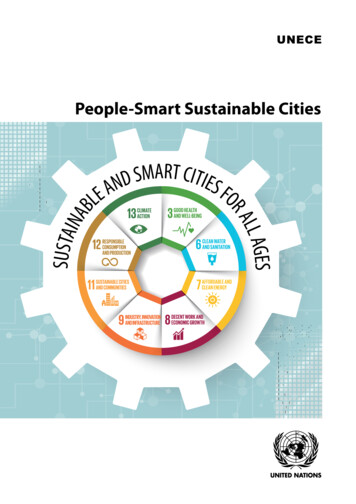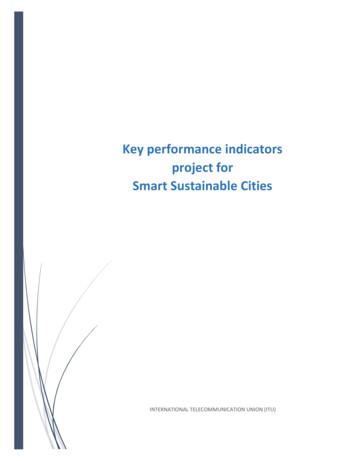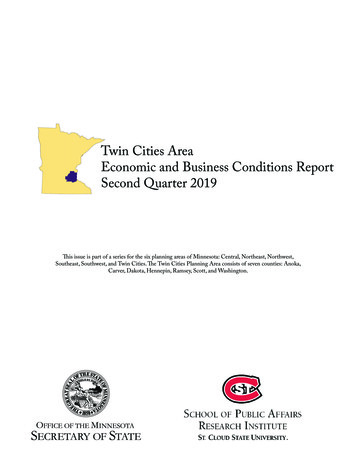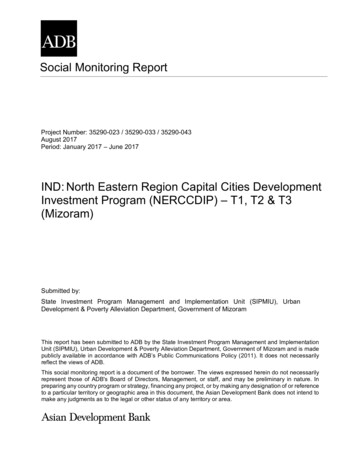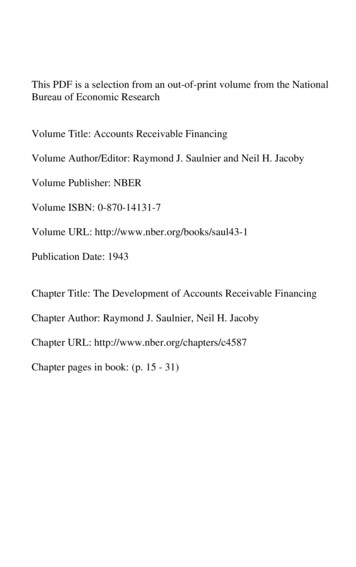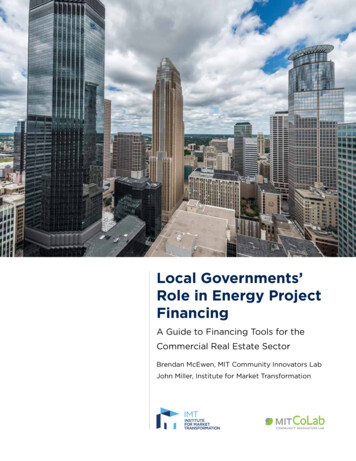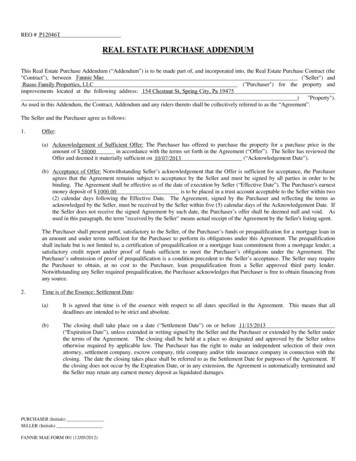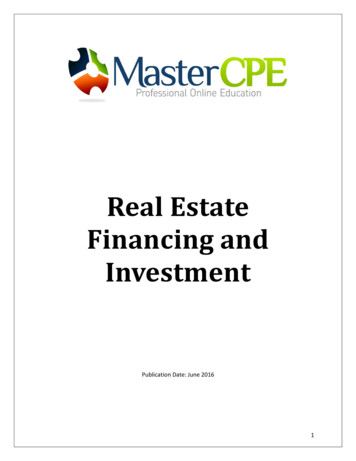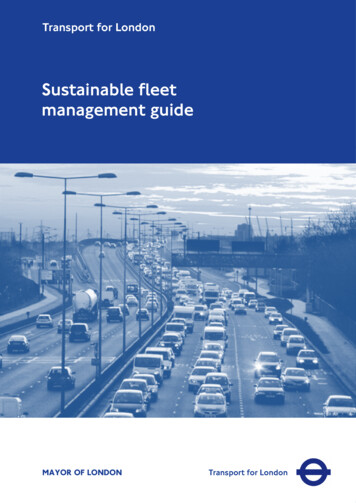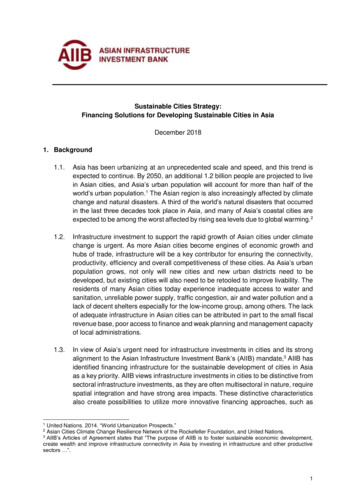
Transcription
Sustainable Cities Strategy:Financing Solutions for Developing Sustainable Cities in AsiaDecember 20181. Background1.1.Asia has been urbanizing at an unprecedented scale and speed, and this trend isexpected to continue. By 2050, an additional 1.2 billion people are projected to livein Asian cities, and Asia’s urban population will account for more than half of theworld’s urban population.1 The Asian region is also increasingly affected by climatechange and natural disasters. A third of the world’s natural disasters that occurredin the last three decades took place in Asia, and many of Asia’s coastal cities areexpected to be among the worst affected by rising sea levels due to global warming.21.2.Infrastructure investment to support the rapid growth of Asian cities under climatechange is urgent. As more Asian cities become engines of economic growth andhubs of trade, infrastructure will be a key contributor for ensuring the connectivity,productivity, efficiency and overall competitiveness of these cities. As Asia’s urbanpopulation grows, not only will new cities and new urban districts need to bedeveloped, but existing cities will also need to be retooled to improve livability. Theresidents of many Asian cities today experience inadequate access to water andsanitation, unreliable power supply, traffic congestion, air and water pollution and alack of decent shelters especially for the low-income group, among others. The lackof adequate infrastructure in Asian cities can be attributed in part to the small fiscalrevenue base, poor access to finance and weak planning and management capacityof local administrations.1.3.In view of Asia’s urgent need for infrastructure investments in cities and its strongalignment to the Asian Infrastructure Investment Bank’s (AIIB) mandate,3 AIIB hasidentified financing infrastructure for the sustainable development of cities in Asiaas a key priority. AIIB views infrastructure investments in cities to be distinctive fromsectoral infrastructure investments, as they are often multisectoral in nature, requirespatial integration and have strong area impacts. These distinctive characteristicsalso create possibilities to utilize more innovative financing approaches, such asUnited Nations. 2014. “World Urbanization Prospects.”Asian Cities Climate Change Resilience Network of the Rockefeller Foundation, and United Nations.3 AIIB’s Articles of Agreement states that “The purpose of AIIB is to foster sustainable economic development,create wealth and improve infrastructure connectivity in Asia by investing in infrastructure and other productivesectors ”.121
financing by land value capture, 4 for infrastructure investments in cities.Nevertheless, AIIB also recognizes that infrastructure investments in cities haveinterlinkages with sectoral infrastructure investments such as energy and intercitytransport. AIIB has thus developed and will implement its Sustainable CitiesStrategy in close coordination with its other sector and thematic strategies.52. Objectives, Comparative Advantages and Guiding Principles2.1.AIIB recognizes that the sustainable development of cities requires a balancedintegration of many economic, financial, environmental and social considerations.AIIB aims to support cities in Asia to be sustainable by promoting the objectives ofgreen, resilient, efficient, accessible and thriving (Table 1). These objectives areconsistent with many Asian cities’ aspirations and the broader global goals, such asthe Sustainable Development Goals, New Urban Agenda, Paris Agreement onClimate Change and Sendai Framework for Disaster Risk Reduction.Table 1: Description of objectives that contribute to sustainable citiesObjectivesDescriptionGreenProtect and enhance environmental sustainability (e.g., pollutionreduction, climate mitigation, conservation and sustainablemanagement of natural resources and biodiversity)ResilientDevelop the ability to withstand both sudden shocks (e.g.,natural disasters) and slow-onset impacts (e.g., through climateadaptation)EfficientDeliver the best possible outputs with the least possible inputs(e.g., reduce congestion) and minimize waste generated duringthe process (e.g., heat, wastewater)AccessibleProvide households (especially low-income and vulnerablegroups) and firms with easier access to infrastructure and socialservicesThrivingContribute to sustained economic growth and job creation2.2.AIIB is well-positioned to support the sustainable development of cities given itsability to directly finance not only national governments, but also subnationalentities, including provincial and city governments and agencies, as well as stateowned and municipal-owned enterprises. In addition, AIIB’s considerable financialresources, ability to provide sovereign-backed and nonsovereign-backed financingwithin the same balance sheet and priority to mobilize private capital intoinfrastructure development will enable the bank to support urban public-privatepartnerships (PPP) and commercially financed solutions.4Financing by land value capture is premised on the principle that the benefits of infrastructure projects arecapitalized into land values and refers to tapping into the increments in land values to fund the respectiveinfrastructure projects.5 Notably, urban transport is covered under AIIB’s Sustainable Cities Strategy, rather than AIIB’s Transport SectorStrategy. Notwithstanding this, AIIB will encourage the urban transport projects that it finances to be integratedwith both the urban transport network and the national/intercity transport network where possible.2
2.3.Taking into consideration AIIB’s primary focus on infrastructure financing and itscomparative advantages, the bank’s long-term aspiration is to provide financingsolutions, with distinct capabilities in supporting subnational entities andmobilizing private capital, for developing sustainable cities that are green,resilient, efficient, accessible and thriving in Asia.2.4.AIIB will be guided by three principles in its infrastructure investments in cities:client-driven; outcome-driven; and financial viability-driven.2.5.Client-driven: AIIB recognizes that subnational governments are increasinglyresponsible for providing urban infrastructure and services. Their in-depthknowledge of local conditions can also facilitate the testing and refinement of theimplementation of innovative solutions locally. Nevertheless, AIIB is also cognizantthat urban governance structures vary considerably across countries in Asia, andthat national governments continue to play an important role in urban development,including in coordinating the overall national development agenda. In addition, whilesome subnational governments have relatively strong creditworthiness and are ableto tap into domestic financial markets, many subnational governments continue tohave a small own-source revenue base that is supplemented by intergovernmentaltransfers and grants. In view of these considerations, AIIB will proactively seek tobuild trusted client relationships with subnational entities, and maintain the flexibilityto work with national governments and private sponsors for financing infrastructureinvestments in cities.2.6.Outcome-driven: AIIB’s infrastructure investments in cities will be delivered mainlywithin the geographical boundaries of cities to largely benefit urban populations.Given the importance of spatial integration in cities, AIIB will proactively seek tosupport infrastructure projects that adopt a more holistic/integrated approach, suchas by being part of a city masterplan and/or by considering strategic/efficient landuse. Notwithstanding the multiple economic, financial, environmental and socialconsiderations that contribute to the sustainable development of cities, AIIB willproactively seek to invest in infrastructure projects that promote the objectives ofgreen, resilient, efficient, accessible and thriving.2.7.As set out in AIIB’s Environmental and Social Framework and Policy, AIIB will seekto ensure environmental and social soundness and sustainability in all its projects,including its infrastructure investments in cities. During the identification,preparation and implementation of AIIB’s projects, the bank will aim to addressenvironmental and social risks and impacts, including for vulnerable groups. Insupporting green economic growth, the bank will encourage making the best use oflow-carbon technologies, renewable energy, cleaner production and energyefficiency, promote the conservation and sustainable management of naturalresources and biodiversity, and support sustainable land-use management.2.8.In addition, AIIB will be supportive of social development and inclusion that arecritical for sound development in a manner consistent with the bank’s Articles ofAgreement. In particular, AIIB recognizes that selected urban infrastructures, suchas urban transport, can have significant potential to improve economic inclusion and3
social outcomes. The bank will encourage the infrastructure projects that it financesin cities to build in such considerations where possible.2.9.Financial viability-driven: In line with AIIB’s mandate to adopt sound bankingprinciples, 6 the bank will prioritize infrastructure investments in cities that arefinancially sound and viable. This is also consistent with AIIB’s priority to mobilizeprivate capital into infrastructure development, including in cities. Notwithstandingthis, to the extent that AIIB’s financial sustainability is preserved, the bank willmaintain the flexibility to selectively support infrastructure investments in cities thatdo not initially offer sufficient financial returns to attract stand-alone private financingbut present significant economic benefits with high social value.3. Implementation Approach and Priorities3.1.AIIB recognizes that the complexity of infrastructure investments in cities isheightened by their multisectoral and multi-stakeholder nature. Given that AIIB isstill a relatively young institution, the bank will adopt a gradual and focusedapproach in its infrastructure investments in cities. Over time, the bank will buildtrusted client relationships and partnerships, strengthen its institutional capacitiesand proactively learn from its growing operational experiences.3.2.Cities: AIIB is open to working with cities of all sizes, from small cities to megacities.Notwithstanding this, in the short term (three years), AIIB will seek to invest in aselected group of cities with higher implementation capacity, particularly wherethere are established city masterplans and where project sponsors have soundfinancial positions and robust governance. Over the medium term (five years), AIIBwill gradually widen its engagements across a larger group of cities, including thosewith more challenging circumstances.3.3.Investment areas: Infrastructure investments in cities can be broadly categorizedinto four areas based on their functions:(a)Enhancing urban mobility: These projects generally contribute to betterphysical access and more efficient connectivity between residential,commercial and industrial areas as well as social services within urbanboundaries, which in turn support trade, economic development and povertyreduction. They may also promote green outcomes by incorporating lowcarbon elements where possible. Examples include: metro systems; bus rapidtransit; infrastructure supporting electric vehicles; pedestrian and nonmotorized transport facilities; multimodal hubs; transit-oriented developments;and traffic management systems.(b)Improving basic infrastructure and city resilience: These projects generally aimto: (i) provide better access to and improve the efficiency of basic infrastructureand services; (ii) promote green outcomes by reducing pollution, incorporatingAIIB’s Articles of Agreement states that “The resources and facilities of the Bank shall be used exclusively toimplement the purpose and functions set forth, respectively, in Articles 1 and 2, and in accordance with soundbanking principles.”64
low-carbon elements and protecting the urban environment where possible;and (iii) enhance resilience against climate change and natural disasters,including through nature-based solutions where feasible, within urbanboundaries. They may deliver multiple benefits and contribute to the overallsustainability of cities. Examples include: solid waste management, watersupply; sewerage; wastewater treatment; urban drainage; flood protection;energy efficiency; and green buildings.(c)Promoting integrated development: These projects generally relate to morecomprehensive and multisectoral development initiatives in a given urban areaor sub-area, where social facilities such as public housing, hospitals andschools may also be part of an overall development initiative. They encouragemore efficient land-use, which in turn supports trade and economicdevelopment, and provide better access to livable areas and social services,thereby improving people’s quality of life. Examples include: industrial parks;special economic zones; commercial business districts; neighborhood wcity/districtdevelopments; and satellite cities.(d)Building freestanding health and education facilities: These projects relate tothe development and improvement of freestanding health and educationfacilities within urban boundaries. Examples include freestanding public:schools; universities; hospitals; and clinics.3.4.AIIB will prioritize investments in three of the above-mentioned areas under thisstrategy (Figure 1). They are (a) enhancing urban mobility, (b) improving basicinfrastructure and city resilience and (c) promoting integrated development. WhileAIIB recognizes that health and education facilities are important for the sustainabledevelopment of cities, it is viewed that such facilities are better managed through asectoral program/approach given the high degree of specialized expertise andpolicy dialogue required in these sectors. Nevertheless, where health and educationfacilities are part of a more comprehensive/multisectoral integrated developmentthat AIIB is considering to finance, AIIB will support the building of such facilitiesunder this strategy as part of the broader integrated development.3.5.AIIB recognizes that the nature of urban population growth (e.g., rural-urbanmigration, natural growth) and changing economic structures have long-termimplications on the spatial transformation of cities. Once built, the physical formsand land-use patterns of cities will likely be locked in for several decades. Takingthis into account, AIIB will consider investing in urban real estate developments tothe extent that they clearly contribute to achieving one or more of AIIB’s identifiedobjectives (green, resilient, efficient, accessible, thriving), present significant publicbenefits beyond private benefits and are part of the city’s integrated masterplan. Inparticular, given the large and growing need for more sustainable and moreaffordable housing in Asia, AIIB will support the development of residential housingwith significant social value, such as public rental housing and affordable housing.This is especially where the housing developments require investments in basicinfrastructure and/or are part of a broader integrated development (e.g., new5
city/district development). AIIB will, however, not prioritize investments in residentialhousing and commercial developments that have largely private benefits and littlesocial value, such as luxury villas.3.6.AIIB will gradually progress from financing relatively investment-ready projects tofinancing more complex projects across the three priority investment areas. Takinginto consideration AIIB’s prevailing client demand and institutional capacity duringits early years of operation, in the short term (three years), AIIB expects itsinfrastructure investments in cities to be largely focused on investment-readyprojects that (a) enhance urban mobility (such as metro systems) and (b) improvebasic infrastructure and city resilience (such as water supply, sewerage, wastewatertreatment and flood management). As AIIB learns from more experienced projectpartners and its growing operations, over the medium term (five years), AIIB expectsthat its projects within each investment area of cities will increase in complexity, andthat its portfolio of infrastructure investments in cities will broaden across the threepriority investment areas and their respective subsectors.3.7.In addition, AIIB recognizes that there is an increasing number of city-basedinitiatives to adopt innovation and digitization to help improve economic, financial,environmental and social outcomes in cities, such as smart cities. Theseinnovations and technologies may be applied across the three priority investmentareas that AIIB has identified, such as intelligent traffic and transit, e-road pricing,smart outdoor lighting, environmental monitoring and smart grid and metering.Where they have shown to be beneficial for the sustainable development of citiesand are scalable in Asian cities, AIIB will also support investments in suchinnovations and technologies.Figure 1: AIIB’s priority areas for infrastructure investments in citiesInvestment areas:Legend: Short-term priority (3 years)Medium-term priority (5 years)Investment-readyEnhance urbanmobilityImprove basic infrastructureand city resiliencePromote integrateddevelopmentMore complex projects Relates to physical accesswithin city boundaries Examples:o Metro; light rail; tram; bustransport; bus rapid transito Low-carbon infrastructure(e.g. infrastructure for electriccars; pedestrian andnon-motorized transportfacilities)o Multimodal hubs; integratedtraffic corridoro Transit-oriented developmento Street; urban roado Traffic management systemsCross-cuttingprinciples: Relates to basic service provision, climateaction, disaster mitigation/adaptation andurban environmental conservation/protection Examples:o Water supply; sewerage; wastewatertreatment; solid waste collection anddisposalo Urban drainage; storm watermanagement; flood protection; waterresource management; sponge cityo Energy efficiency; green buildings; greeninfrastructureo Public rental housing; public spaceso Urban data infrastructureo Electricity distribution Relates to morecomprehensive/multisectoraldevelopments in a given area;may include social facilities aspart of the overall development Examples:o Industrial parks; specialeconomic zoneso Commercial business districtso Neighborhood (slum)upgradingo Urban redevelopment/regenerationo New city/district development;satellite citiesNot prioritized under this strategyBuild freestandinghealth/educationfacilities Relates tofreestanding healthand educationfacilities that would bebetter managedthrough a sectoralprogram/approach Examples:o Education sector:Public schools;universitieso Health sector:Public hospitals;clinicsIntegrated across sectors and embrace innovative solutions/proven technologiesClient-driven, outcome-driven and financial viability-drivenCatalyze private capital3.8.Financing instruments: AIIB will aim to offer a variety of financing instruments thatcan support government financing, private financing and PPPs to deliver the bestdevelopment outcomes for cities. With regard to government finance, in addition toproviding sovereign-backed financing, AIIB will initially seek to support subnational6
entities with higher implementation capacity through subnational finance withoutsovereign guarantee. Over time, AIIB will seek to widen its range of nonsovereignbacked financing instruments and develop scalability in its more innovativefinancing instruments, such as local currency financing, credit enhancements formunicipal bonds and green finance. As appropriate, financing to subnational entitieswill be conducted in consultation with relevant national authorities. On privatefinancing, AIIB will make efforts in accordance to the priorities set out in its Strategyon Mobilizing Private Capital for Infrastructure. AIIB will also use its Special Fund tosupport project preparation for its infrastructure investments in cities, especiallywhere there is clear potential to improve project bankability and catalyze privateinvestments.3.9.Strategic partnerships: AIIB will continue to work closely with its existing partnersand build new strategic partnerships. The bank will work with other financialinstitutions, including multilateral development banks (MDBs), bilateral aid agenciesand organizations providing concessionary finance, to cofinance projects. This willhelp clients to overcome financing challenges for more complex projects and helpAIIB to strengthen its institutional capacity. The bank also recognizes theimportance of upstream engagement and the efforts being undertaken bydevelopment partner institutions and initiatives. In addition to the MDBs, the bankwill seek to collaborate with international and regional urban initiatives, such as 100Resilient Cities, Global Green Growth Institute (GGGI), Local Governments forSustainability (ICLEI) and the United Nations Human Settlements Programme (UNHabitat), to identify projects in the early stage and complement the bank’s leanbusiness model where possible. AIIB will build on these partnerships to develop amore granular understanding of and deepen its expertise in areas that are withinthe bank’s mandate and where the bank has the potential to add significant value.4. Results Monitoring Framework4.1.All of AIIB’s investments, including those in cities, will be prepared and implementedwith the aim to ensure high quality and a focus on delivering results, while ensuringcost-effectiveness to clients and maintaining the bank’s lean business model. AIIBwill gradually build the capacity to monitor the results of each of its infrastructureinvestments in cities towards achieving one or more of the identified objectives(green, resilient, efficient, accessible, thriving) as relevant. The bank recognizes thatsuch project-level approach to results monitoring is more suitable for some of itsidentified objectives, such as accessibility which includes equality of opportunityacross gender and income groups, and for the multisectoral nature of infrastructureinvestments in cities, where challenges due to cross-sectoral aggregation mayarise. The bank will seek to learn from the experiences and good practices of otherMDBs and the private sector. Key indicators will be selected on the basis that theyare clear, relevant and monitorable. Examples of project-level outcome measuresrelated to the identified objectives that are used by other institutions are provided inAnnex A. Where possible, AIIB will seek to develop aggregates of selected projectlevel indicators and incorporate them into the portfolio-level results monitoringframework over time.7
4.2.At the portfolio level, AIIB will monitor its investments in cities towards achieving theidentified objectives (green, resilient, efficient, accessible, thriving) by investmentamount and by share of its sustainable cities portfolio (Table 2). Where relevant, thebank will also apply its results monitoring frameworks for individual sectors, such asenergy and transport, to its infrastructure investments in cities. AIIB will also monitorits capacity to provide financing solutions for developing sustainable cities, includingits capacity to support subnational entities and to mobilize private capital intoinfrastructure investments in cities. These indicators will be revisited and refined asthe bank gains more operational experience over time.Table 2: Results monitoring framework for AIIB’s Sustainable Cities StrategyObjectivesIndicatorsGreen USD and percent of financing for projects incities that promote green development.Resilient USD and percent of financing for projects incities that promote resilience.Efficient USD and percent of financing for projects incities that promote efficiency.Accessible USD and percent of financing for projects incities that promote accessibility.Thriving USD and percent of financing for projects incities that promote economic growth.Capacity to provide financing Number of cities in which AIIB has investedsolutions for developingin projects towards achieving one or moresustainable cities, including:of the identified objectives (green, resilient, Supporting subnationalefficient, accessible, thriving).entities Percent of projects in cities in which Mobilizing private capitalfinancing is provided to subnational entities. USD and percent of financing for projects incities in which financing is provided to theprivate sector. Private capital mobilized.74.3.7As AIIB gains more operational experience and builds deeper institutional capacity,the bank will periodically review and refine the Sustainable Cities Strategy asappropriate. The timing of such reviews will be agreed with the bank’s Board ofDirectors in the context of the bank’s annual Business Plan.Cross-reference to indicators as set out in AIIB’s Strategy on Mobilizing Private Capital for Infrastructure.8
Annex A:Examples of project-level outcome indicatorsObjectivesGreenDescriptionProtect and enhance environmental sustainability(e.g., pollution reduction, climate mitigation,conservation and sustainable management ofnatural resources and biodiversity)ResilientDevelop the ability to withstand both suddenshocks (e.g., natural disasters) and slow-onsetimpacts (e.g., through climate adaptation)Deliver the best possible outputs with the leastpossible inputs (e.g., reduce congestion) andminimize waste generated during the process(e.g., heat, wastewater)Provide households (especially low-income andvulnerable groups) and firms with easier access toinfrastructure and social servicesEfficientAccessibleThriving8Contribute to sustained economic growth andjob creationIllustrative project-level outcome indicators (unit) Greenhouse gas emission reduced (tons of CO2 equivalent per year) NOx and/or SO2 reduced (tons per year) Particulate matter (e.g. PM10, PM2.5) reduced (micrograms per cubicmeter) Chemical oxygen demand reduced (milligrams per liter) People benefitting from disaster and/or climate resilient projects(number) Travel time reduced (minutes) Industrial or municipal waste reduced or recycled (tons per year) Households provided with improved urban living conditions, such asimproved water supply, improved sanitation, regular solid wastecollection, all-season roads, electricity (number and percent) Public transport trips by gender (number and percent) Private capital mobilized8 (USD) Direct employment generated during construction and duringoperation (number)Cross-reference to indicators as set out in AIIB’s Strategy on Mobilizing Private Capital for Infrastructure.9
2.3. Taking into consideration AIIB's primary focus on infrastructure financing and its comparative advantages, the bank's long-term aspiration is to provide financing solutions, with distinct capabilities in supporting subnational entities and mobilizing private capital, for developing sustainable cities that are green,
